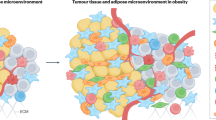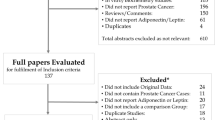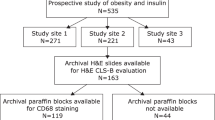Abstract
Background:
Obesity, a cause of subclinical inflammation, is associated with increased risk of high-grade prostate cancer (PC) and poor outcomes. Whether inflammation occurs in periprostatic white adipose tissue (WAT), and contributes to the negative impact of obesity on PC aggressiveness, is unknown.
Methods:
In a single-center, cross-sectional design, men with newly diagnosed PC undergoing radical prostatectomy were eligible for study participation. The primary objective was to examine the prevalence of periprostatic WAT inflammation defined by the presence of crown-like structures (CLS-P) as detected by CD68 immunohistochemistry. Secondary objectives were to explore the clinical and systemic correlates of periprostatic WAT inflammation. Tumor characteristics and host factors including BMI, adipocyte diameter, and circulating levels of lipids, adipokines, and other metabolic factors were measured. Wilcoxon rank-sum, Chi-square, or Fisher’s exact tests, and generalized linear regression were used to examine the association between WAT inflammation and tumor and host characteristics.
Results:
Periprostatic fat was collected from 169 men (median age 62 years; median BMI 28.3). Periprostatic WAT inflammation was identified in 49.7% of patients and associated with higher BMI (P=0.02), larger adipocyte size (P=0.004) and Gleason grade groups IV/V tumors (P=0.02). The relationship between WAT inflammation and high Gleason grade remained significant after adjusting for BMI (P=0.04). WAT inflammation correlated with higher circulating levels of insulin, triglycerides, and leptin/adiponectin ratio, and lower high density lipoprotein cholesterol, compared to those without WAT inflammation (P’s <0.05).
Conclusion:
Periprostatic WAT inflammation is common in this cohort of men with PC and is associated with high-grade PC.
This is a preview of subscription content, access via your institution
Access options
Subscribe to this journal
Receive 4 print issues and online access
$259.00 per year
only $64.75 per issue
Buy this article
- Purchase on Springer Link
- Instant access to full article PDF
Prices may be subject to local taxes which are calculated during checkout



Similar content being viewed by others
References
Discacciati A, Orsini N, Wolk A . Body mass index and incidence of localized and advanced prostate cancer—a dose-response meta-analysis of prospective studies. Ann Oncol 2012; 23: 1665–1671.
Cao Y, Ma J . Body mass index, prostate cancer-specific mortality, and biochemical recurrence: a systematic review and meta-analysis. Cancer Prev Res 2011; 4: 486–501.
Zhang X, Zhou G, Sun B, Zhao G, Liu D, Sun J et al. Impact of obesity upon prostate cancer-associated mortality: a meta-analysis of 17 cohort studies. Oncol Lett 2015; 9: 1307–1312.
Ribeiro R, Monteiro C, Catalan V, Hu P, Cunha V, Rodriguez A et al. Obesity and prostate cancer: gene expression signature of human periprostatic adipose tissue. BMC Med 2012; 10: 108.
Finley DS, Calvert VS, Inokuchi J, Lau A, Narula N, Petricoin EF et al. Periprostatic adipose tissue as a modulator of prostate cancer aggressiveness. J Urol 2009; 182: 1621–1627.
Laurent V, Guerard A, Mazerolles C, Le Gonidec S, Toulet A, Nieto L et al. Periprostatic adipocytes act as a driving force for prostate cancer progression in obesity. Nat Commun 2016; 7: 10230.
Zhang T, Tseng C, Zhang Y, Sirin O, Corn PG, Li-Ning-Tapia EM et al. CXCL1 mediates obesity-associated adipose stromal cell trafficking and function in the tumour microenvironment. Nat Commun 2016; 7: 11674.
van Roermund JG, Hinnen KA, Tolman CJ, Bol GH, Witjes JA, Bosch JL et al. Periprostatic fat correlates with tumour aggressiveness in prostate cancer patients. BJU Int 2011; 107: 1775–1779.
Woo S, Cho JY, Kim SY, Kim SH . Periprostatic fat thickness on MRI: correlation with Gleason score in prostate cancer. AJR Am J Roentgenol 2015; 204: W43–W47.
Allott EH, Howard LE, Song HJ, Sourbeer KN, Koontz BF, Salama JK et al. Racial differences in adipose tissue distribution and risk of aggressive prostate cancer among men undergoing radiotherapy. Cancer Epidemiol Biomarkers Prev 2014; 23: 2404–2412.
Olefsky JM, Glass CK . Macrophages, inflammation, and insulin resistance. Annu Rev Physiol 2010; 72: 219–246.
Iyengar NM, Hudis CA, Dannenberg AJ . Obesity and cancer: local and systemic mechanisms. Ann Rev Med 2015; 66: 297–309.
Cinti S, Mitchell G, Barbatelli G, Murano I, Ceresi E, Faloia E et al. Adipocyte death defines macrophage localization and function in adipose tissue of obese mice and humans. J Lipid Res 2005; 46: 2347–2355.
Shapiro H, Pecht T, Shaco-Levy R, Harman-Boehm I, Kirshtein B, Kuperman Y et al. Adipose tissue foam cells are present in human obesity. J Clin Endocrinol Metab 2013; 98: 1173–1181.
Iyengar NM, Zhou XK, Gucalp A, Morris PG, Howe LR, Giri DD et al. Systemic correlates of white adipose tissue inflammation in early-stage breast cancer. Clin Cancer Res 2016; 22: 2283–2289.
Koru-Sengul T, Santander AM, Miao F, Sanchez LG, Jorda M, Gluck S et al. Breast cancers from black women exhibit higher numbers of immunosuppressive macrophages with proliferative activity and of crown-like structures associated with lower survival compared to non-black Latinas and Caucasians. Breast Cancer Res Treat 2016; 158: 113–126.
Iyengar NM, Ghossein RA, Morris LG, Zhou XK, Kochhar A, Morris PG et al. White adipose tissue inflammation and cancer-specific survival in patients with squamous cell carcinoma of the oral tongue. Cancer 2016; 122: 3794–3802.
Epstein JI, Zelefsky MJ, Sjoberg DD, Nelson JB, Egevad L, Magi-Galluzzi C et al. A contemporary prostate cancer grading system: a validated alternative to the Gleason score. Eur Urol 2016; 69: 428–435.
Morris PG, Hudis CA, Giri D, Morrow M, Falcone DJ, Zhou XK et al. Inflammation and increased aromatase expression occur in the breast tissue of obese women with breast cancer. Cancer Prev Res 2011; 4: 1021–1029.
Iyengar NM, Morris PG, Zhou XK, Gucalp A, Giri D, Harbus MD et al. Menopause is a determinant of breast adipose inflammation. Cancer Prev Res 2015; 8: 349–358.
Subbaramaiah K, Howe LR, Bhardwaj P, Du B, Gravaghi C, Yantiss RK et al. Obesity is associated with inflammation and elevated aromatase expression in the mouse mammary gland. Cancer Prev Res 2011; 4: 329–346.
Kawasaki N, Asada R, Saito A, Kanemoto S, Imaizumi K . Obesity-induced endoplasmic reticulum stress causes chronic inflammation in adipose tissue. Sci Rep 2012; 2: 799.
Amano SU, Cohen JL, Vangala P, Tencerova M, Nicoloro SM, Yawe JC et al. Local proliferation of macrophages contributes to obesity-associated adipose tissue inflammation. Cell Metab 2014; 19: 162–171.
Hammarsten J, Hogstedt B . Hyperinsulinaemia: a prospective risk factor for lethal clinical prostate cancer. Eur J Cancer 2005; 41: 2887–2895.
Cox ME, Gleave ME, Zakikhani M, Bell RH, Piura E, Vickers E et al. Insulin receptor expression by human prostate cancers. Prostate 2009; 69: 33–40.
Lubik AA, Gunter JH, Hendy SC, Locke JA, Adomat HH, Thompson V et al. Insulin increases de novo steroidogenesis in prostate cancer cells. Cancer Res 2011; 71: 5754–5764.
Allott EH, Howard LE, Cooperberg MR, Kane CJ, Aronson WJ, Terris MK et al. Serum lipid profile and risk of prostate cancer recurrence: results from the SEARCH database. Cancer Epidemiol Biomarkers Prev 2014; 23: 2349–2356.
Li H, Stampfer MJ, Mucci L, Rifai N, Qiu W, Kurth T et al. A 25-year prospective study of plasma adiponectin and leptin concentrations and prostate cancer risk and survival. Clin Chem 2010; 56: 34–43.
Rodriguez C, Freedland SJ, Deka A, Jacobs EJ, McCullough ML, Patel AV et al. Body mass index, weight change, and risk of prostate cancer in the Cancer Prevention Study II Nutrition Cohort. Cancer Epidemiol Biomarkers Prev 2007; 16: 63–69.
Giovannucci E, Rimm EB, Liu Y, Leitzmann M, Wu K, Stampfer MJ et al. Body mass index and risk of prostate cancer in U.S. health professionals. J Natl Cancer Inst 2003; 95: 1240–1244.
Acknowledgements
We thank all the patients who generously volunteered to participate in this study. This work was supported by the Prostate Cancer Foundation (Movember-Challenge Award), Patricia and William Kleh, and Memorial Sloan Kettering Cancer Center Support Grant/Core Grant (P30 CA008748). LWJ is supported by grants from the National Cancer Institute and Aktiv Against Cancer.
Author information
Authors and Affiliations
Corresponding author
Ethics declarations
Competing interests
The authors declare no conflict of interest.
Rights and permissions
About this article
Cite this article
Gucalp, A., Iyengar, N., Zhou, X. et al. Periprostatic adipose inflammation is associated with high-grade prostate cancer. Prostate Cancer Prostatic Dis 20, 418–423 (2017). https://doi.org/10.1038/pcan.2017.31
Received:
Revised:
Accepted:
Published:
Issue Date:
DOI: https://doi.org/10.1038/pcan.2017.31
This article is cited by
-
Mechanisms of obesity- and diabetes mellitus-related pancreatic carcinogenesis: a comprehensive and systematic review
Signal Transduction and Targeted Therapy (2023)
-
SARS-CoV-2 infection induces persistent adipose tissue damage in aged golden Syrian hamsters
Cell Death & Disease (2023)
-
INPP4B protects from metabolic syndrome and associated disorders
Communications Biology (2021)
-
Peri-prostatic adipose tissue measurements using MRI predict prostate cancer aggressiveness in men undergoing radical prostatectomy
Journal of Endocrinological Investigation (2021)
-
Pre-treatment ratio of periprostatic to subcutaneous fat thickness on MRI is an independent survival predictor in hormone-naïve men with advanced prostate cancer
International Journal of Clinical Oncology (2020)



